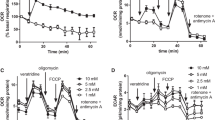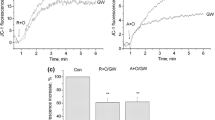Abstract
The resting pH of 7.14±0.02 within rat cortical synaptosomes is elevated in vitro by the insecticide chlordecone, in a dose-dependent manner. Chlordecone also reduces the rate of oxygen radical formation within synaptosomes. Both of these changes can also be demonstrated following in vivo treatment of rats with chlordecone (75 mg/kg body wt). Although chlordecone increases the permeability of the plasma membrane, the increase in pH observed is unlikely to be caused by this, since in vivo administration of chlordecone does not appreciably alter membrane order as evaluated by both a lipophilic probe, and a probe with an ionic segment. Another xenobiotic agent, methyl mercuric chloride, and a free radical generating system, an ascorbic acid-ferrous sulfate mixture, did not modulate synaptosomal pH, although membrane permeability was increased. Other evidence of the ability of synaptosomes to maintain homeostasis was the failure of mitochondrial inhibitors to significantly reduce pH. The drop in synaptosomal pH effected by amiloride, an inhibitor of Na+/H+ exchange, and the transient rise in pH caused by ammonium chloride further suggested that synaptosomes may be a good model in the study of the regulation of intracellular pH. The elevation of cytosolic pH, and depression of oxygen radical formation by chlordecone, may result from both the attenuation of respiratory metabolism and an impaired capacity of the plasma membrane to maintain ionic gradients.
Similar content being viewed by others
References
Bass D. A., Parce J. W., Dechatelet L. R., Szeda P., Seeds M. C., and Thomas M. (1983) Flow cytometric studies of oxidative product formation by neutrophils: a graded response to membrane stimulation.J. Immunol. 130, 1910–1917.
Bondy S. C. and Halsall L. C. (1988) GM1 ganglioside enhances synaptosomal resistance to chemically induced damage.Neurosci. Lett. 84, 229–233.
Bondy S. C. and Hong J. S. (1987) Modulation of adrenal ornithine decarboxylase by chlordecone, p,p′-DDT and permethrin.Neurotoxicology 8, 15–22.
Bondy S. C., McKee M., and Davoodbhoy Y. M. (1990) Prevention of chemically induced changes in synaptosomal membrane order by ganglioside GM1 and α-tocopherol.Biochim. Biophys. Acta (in press).
Carmines E. L., Carchman R. A., and Borzellica J. F. (1979) Kepone: cellular sites of action.Toxicol. Appl. Pharmacol. 49, 543–550.
Dodd P. R., Hardy J. A., Oakley A. E., Edwardson J. A., Perry E. K., and Delaunoy J. P. (1981) A rapid method of preparing synaptosomes: comparison with alternative procedures.Brain Res. 226, 107–118.
Drapeau P. and Nachshen D. A., (1988) Effects of lower extracellular and cytosolic pH on calcium fluxes, cytosolic calcium levels and transmitter release in presynaptic nerve endings isolated from rat brain.J. Gen. Physiol. 91, 305–315.
Fong W. F. and Law C. L. (1988) The induction of ornithine decarboxylase by 1-asparagine and intracellular alkalinization.Biochem. Int. 16, 279–285.
Gray E. G. and Whittaker V. P. (1962) The isolation of nerve endings from brain: an electron microscopic study of cell fragments derived by homogenization and centrifugation.J. Anat. 96, 79–88.
Isom G. E., Borowitz J. L., and Maduh E. U. (1990) Cyanide induced alteration of cystosolic proton homeostasis.The Toxicologist 10, 111.
Komulainen H. and Bondy S. C. (1987) Modulation of levels of free calcium within synaptosomes by organochlorine insecticides.J. Pharmacol. Exptl. Therap. 241, 575–581.
Kuhry J. G., Fontaneau P., Duportal G., Maechling C., and Laustrait G. (1983) TMA-DPH: a suitable fluorescence probe for specific plasma membrane studies in intact living cells.Cell Biophysics 5, 129–140.
LeBel C. P. and Bondy S. C. (1990) Sensitive and rapid quantification of oxygen reactive species formation in rat synaptosomes.Neurochem. Internat. (in press).
LeBel C. P., Ali S. F., McKee M., and Bondy S. C. (1990a) Organometal-induced increases in oxygen reactive species: The potential of 2′7′-dichlorofluorescin diacetate as an index of neurotoxic damage.Toxicol. Appl. Pharmacol. (in press).
LeBel C. P., Ischiropolis H., and Bondy S. C. (1990b) Fluorometric detection of reactive oxygen species: characterization of the probe 2′, 7′-dichlorofluorescin.Anal. Biochem. (in press).
Madshus I. H. (1988) Regulation of intracellular pH in eukaryotic cells.Biochem. J. 250, 1–8.
Prendergast F. G., Hoagland R. P., and Callahan P. J. (1981) 1-[4-(trimethylamino)-phenyl]-6-phenylhexa-1,3,5-triene: synthesis, fluorescence properties, and use as a fluoroscence probe of lipid bilayers.Biochemistry 20, 7333–7338.
Rink T. J., Tsien R. Y., and Pozzan T. (1982) Cytoplasmic pH and free Mg2+ in lymphocytes.J. Cell Biol. 95, 189–196.
Richards C. D., Metcalfe J. C., Smith G. A., and Heketh T. R. (1984) Changes in free calcium levels and pH in synaptosomes during transmitter release.Biochim. Biophys. Acta 803, 215–220.
Shinitzky M. and Barenholz Y. (1978) Fluidity parameters of lipid regions determined by fluorescence polarization.Biochim. Biophys. Acta 515, 367–394.
Taylor J. R., Selhorst J. B., and Calbrese V. P. (1980) Chlordecone,Clinical Neurotoxicology (Spencer P. S. and Schaumburg H. H., eds.) pp. 407–421. Williams and Wilkins, Baltimore.
Thomas J. A., Buchsbaum R. N., Zimniak A., and Racker E. (1979) Intracellular pH measurements in Ehrlich ascites tumor cells utilizing spectroscopic probes generatedin situ.Biochemistry 18, 2210–2218.
Vassort G., Whittembury J., and Mullins L. J. (1986) Increases in intracellular Ca2+ and decreases in internal H+ are induced by general anesthetics in squid axons.Biophys. J. 50, 11–19.
White E. J., Juchniewicz H. J., and Clark J. B. (1989) Effects of lactic acidosis on the function of cerebral cortical synaptosomes.J. Neurochem. 52, 154–161.
Author information
Authors and Affiliations
Rights and permissions
About this article
Cite this article
Bondy, S.C., McKee, M. & Le Bel, C.P. Changes in synaptosomal pH and rates of oxygen radical formation induced by chlordecone. Molecular and Chemical Neuropathology 13, 95–106 (1990). https://doi.org/10.1007/BF03159911
Received:
Accepted:
Issue Date:
DOI: https://doi.org/10.1007/BF03159911




